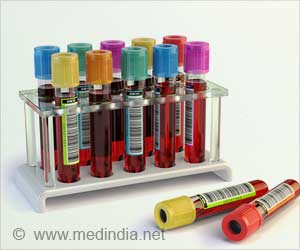By recognizing sugars, a technique developed by University of Michigan analytical chemist Kristina Hakansson sets
ANN ARBOR, Mich.—By recognizing sugars, a technique developed by University of Michigan analytical chemist Kristina Hakansson sets the stage for new cancer diagnosis and treatment options.
A growing body of evidence points to assemblies of sugars called glycans attached to proteins on cancer cell surfaces as accomplices in the growth and spread of tumors. Researchers have been keen to characterize these glycans, but traditional analytical methods have not been sufficient. Now, Hakansson's research group has demonstrated that their technique can be used to identify and structurally characterize glycans. Their work is described in the April 15 issue of the journal Analytical Chemistry. Typically, analytical chemists use mass spectrometry—a technique that accurately weighs molecules or fragments of molecules—to analyze proteins. In this process, proteins are introduced into the mass spectrometer and fragmented by heating until the weakest bonds break. "It's the 'shake-it-til-it-breaks' approach," Hakansson said.Together, the masses of the various fragments provide a sort of fingerprint that reveals the genetic blueprint from which the protein was built—information that helps researchers confirm the protein's identity. This works fine as long as the protein has not been modified after it was produced. But if other chemical groups such as phosphates, sulfates or sugars have been added, the identification method breaks down.
"If sugars are attached, for instance, the weakest bonds are not the bonds that hold the protein together; they're the bonds between the sugars," Hakansson said. When those bonds break, the resulting fragments don't give accurate information about either the protein's identity or the exact type and position of sugars present.
To get around that problem, researchers have used a process called electron capture dissociation (ECD) instead of the usual "shake-it-til-it breaks" method to fragment proteins. But that method requires the presence of at least two positive charges, which can be difficult to accomplish with acidic molecules, such as proteins with sulfate or phosphate groups attached.
Hakansson's group has been exploring the use of metals such as calcium and iron to carry the necessary positive charges. In a series of recently published papers, they first showed that their method can be used to selectively cleave different bonds and then demonstrated that it can be used to identify sulfate-laden proteins and to pinpoint the location of the sulfate groups on them.
In the latest research, they extended the technique to sugars, an even more challenging task.
Advertisement
In a project that continues to build on this line of work, Hakansson is collaborating with U-M Health System cancer surgeon Diane Simeone to investigate sugars attached to proteins in the membranes of pancreatic cancer cells.
Advertisement
Source-Eurekalert
SRM








